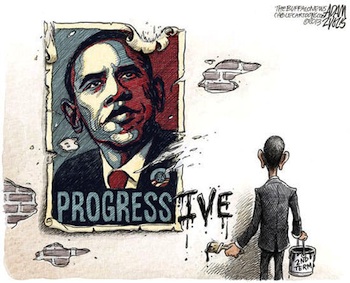Though politicians like Bernie Sanders and Hillary Clinton enjoy pushing the idea that the progressive left is a friend to minorities, in point of fact, nothing could be further from the truth. From eugenics to the racist roots of the minimum wage and gun laws, the progressives have been doing everything to keep non-whites down.
(Reason) The Progressive movement swept America from roughly  the early 1890s through the early 1920s, producing a broad popular consensus that government should be the primary agent of social change. To that end, legions of idealistic young crusaders, operating at the local, state, and federal levels, seized and wielded sweeping new powers and enacted a mountain of new legislation, including minimum wage and maximum hour laws, antitrust statutes, restrictions on the sale and consumption of alcohol, appropriations for hundreds of miles of roads and highways, assistance to new immigrants and the poor, women’s suffrage, and electoral reform, among much else.
the early 1890s through the early 1920s, producing a broad popular consensus that government should be the primary agent of social change. To that end, legions of idealistic young crusaders, operating at the local, state, and federal levels, seized and wielded sweeping new powers and enacted a mountain of new legislation, including minimum wage and maximum hour laws, antitrust statutes, restrictions on the sale and consumption of alcohol, appropriations for hundreds of miles of roads and highways, assistance to new immigrants and the poor, women’s suffrage, and electoral reform, among much else.
Today many on the liberal left would like to revive that movement and its aura of social justice. Journalist Bill Moyers, speaking at a conference sponsored by the left-wing Campaign for America’s Future, described Progressivism as “one of the country’s great traditions.” Progressives, he told the crowd, “exalted and extended the original American Revolution. They spelled out new terms of partnership between the people and their rulers. And they kindled a flame that lit some of the most prosperous decades in modern history.”
Yet the Progressive Era was also a time of vicious, state-sponsored racism. In fact, from the standpoint of African-American history, the Progressive Era qualifies as arguably the single worst period since Emancipation. The wholesale disfranchisement of Southern black voters occurred during these years, as did the rise and triumph of Jim Crow. Furthermore, as the Westminster College historian David W. Southern notes in his recent book, The Progressive Era and Race: Reform and Reaction, 1900–1917, the very worst of it—disfranchisement, segregation, race baiting, lynching—“went hand-in-hand with the most advanced forms of southern progressivism.” Racism was the norm, not the exception, among the very crusaders romanticized by today’s activist left.
At the heart of Southern’s flawed but useful study is a deceptively simple question: How did reformers infused with lofty ideals embrace such abominable bigotry? His answer begins with the race-based pseudoscience that dominated educated opinion at the turn of the 20th century. “At college,” Southern notes, “budding progressives not only read exposés of capitalistic barons and attacks on laissez-faire economics by muckraking journalists, they also read racist tracts that drew on the latest anthropology, biology, psychology, sociology, eugenics, and medical science.”
Popular titles included Charles Carroll’s The Negro a Beast (1900) and R.W. Shufeldt’s The Negro, a Menace to American Civilization (1907). One bestseller, Madison Grant’s The Passing of the Great Race (1916), discussed the concept of “race suicide,” the theory that inferior races were out-breeding their betters. President Theodore Roosevelt was one of many Progressives captivated by this notion: He opposed voting rights for African-American men, which were guaranteed by the 15th amendment, on the grounds that the black race was still in its adolescence.
Such thinking, which emphasized “expert” opinion and advocated sweeping governmental power, fit perfectly within the Progressive worldview, which favored a large, active government that engaged in technocratic, paternalistic planning. As for reconciling white supremacy with egalitarian democracy, keep in mind that when a racist Progressive championed “the working man,” “the common man,” or “the people,” he typically prefixed the silent adjective white.
For a good illustration, consider Carter Glass of Virginia. Glass was a Progressive state and U.S. senator and, as chairman of the House Committee on Banking and Currency, one of the major architects of the Federal Reserve Act of 1913. He was also an enthusiastic supporter of his state’s massive effort to disfranchise black voters. “Discrimination! Why that is exactly what we propose,” he declared to one journalist. “To remove every negro voter who can be gotten rid of, legally, without materially impairing the numerical strength of the white electorate.”
Then there was political scientist John R. Commons, an adviser to the Progressive Wisconsin governor and senator Robert M. LaFollette and a member of Theodore Roosevelt’s Immigration Commission. Commons, the author ofRaces and Immigrants in America (1907), criticized immigration on both protectionist grounds (he believed immigrants depressed wages and weakened labor unions) and racist ones (he wrote that the so-called tropical races were “indolent and fickle”).
Woodrow Wilson, whose Progressive presidential legacy includes the Federal Reserve System, a federal loan program for farmers, and an eight-hour workday for railroad employees, segregated the federal bureaucracy in Washington, D.C. “I have recently spent several days in Washington,” the black leader Booker T. Washington wrote during Wilson’s first term, “and I have never seen the colored people so discouraged and bitter as they are at the present time.”
Perhaps the most notorious figure of the era was Benjamin “Pitchfork” Tillman, a leading Southern Progressive and inveterate white supremacist. As senator from South Carolina from 1895 to 1918, Tillman stumped for “Free Silver,” the economic panacea of the agrarian populist (and future secretary of state) William Jennings Bryan, whom Tillman repeatedly supported for president. “Pitchfork” Tillman favored such Progressive staples as antitrust laws, railroad regulations, and public education, but felt the latter was fit only for whites. “When you educate a negro,” he brayed, “you educate a candidate for the penitentiary or spoil a good field hand.”
Nor did African Americans always fare better among those radicals situated entirely to the left of the Progressives. Socialist Party leader Eugene V. Debs, though personally sympathetic to blacks, declared during his 1912 campaign for the presidency, “We have nothing special to offer the Negro.” Other leading radicals offered even less. Writing in the Socialist Democratic Herald, Victor Berger, the leader of the party’s right wing, declared that “there can be no doubt that the negroes and mulattoes constitute a lower race—that the Caucasian and even the Mongolian have the start on them in civilization by many years.” The celebrated left-wing novelist Jack London, covering the 1908 heavyweight title bout between black challenger Jack Johnson and white boxing champ Tommy Burns, filled his New York Herald story with lurid ethnic caricatures and incessant race baiting. “Though he was a committed socialist,” observed Jack Johnson biographer Geoffrey C. Ward, London’s “solidarity with the working class did not extend to black people.”
As Southern thoroughly documents, these examples just begin to scratch the surface. Progressivism was infested with the most repugnant strains of racism. But was there something more, something inherent in Progressivism itself that facilitated the era’s harsh treatment of blacks? According to Southern, who repeatedly maintains that racism derailed “the great promise” of Progressivism, the answer is no. “The ideas of race and color were powerful, controlling elements in progressive social and political thinking,” he argues. “And this fixation on race explains how democratic reform and racism went hand-in-hand.”
That is surely correct, but is it the whole story? As the legal scholar Richard Epstein has noted, “the sad but simple truth is that the Jim Crow resegregation of America depended on a conception of constitutional law that gave property rights short shrift, and showed broad deference to state action under the police power.” Progressivism itself, in other words, granted the state vast new authority to manage all walks of American life while at the same time weakening traditional checks on government power, including property rights and liberty of contract. Such a mixture was ripe for the racist abuse that occurred.
Take the Supreme Court’s notorious decision in Plessy v. Ferguson (1896), a case that has rightly come to symbolize the South’s Jim Crow regime. In Plessy, the Court considered a Louisiana statute forbidding railroads from selling first-class tickets to blacks, a clear violation of economic liberty. In its 7–1 ruling, the Court upheld segregation in public accommodations so long as “separate but equal” facilities were provided for each race, setting off an orgy of legislation throughout the old Confederacy. South Carolina, for example, segregated trains two years after Plessy. Streetcars followed in 1905, train depots and restaurants in 1906, textile plants in 1915–16, circuses in 1917, pool halls in 1924, and beaches in 1934.
No doubt many of those businesses would have excluded or mistreated black customers whatever the law. But in a market free from Jim Crow regulations, other businesses would have welcomed blacks, or at least black dollars, forcing racist enterprises to bear the full cost of excluding or mistreating all those potential paying customers. (This was one of the chief reasons the segregationists pushed for those laws in the first place.) The state, in the eloquent words of the historian C. Vann Woodward, granted “free rein and the majesty of the law to mass aggressions that might otherwise have been curbed, blunted, or deflected.”
Furthermore, this tangled web of regulations, ordinances, codes, and controls was spun during the heyday of Progressivism, precisely when such official actions were least likely to receive any meaningful scrutiny. Southern, despite his otherwise close attention to the many permutations of race and racism, fails to recognize this major defect in the Progressive worldview.
A similar failure handicaps his treatment of one of the era’s rare victories for African Americans. In Buchanan v. Warley(1917), the Supreme Court unanimously overturned a Louisville ordinance segregating residential housing blocks by race. The case involved a voluntary contract between a white seller and a black buyer for a housing lot located in a majority-white neighborhood. Under the law, the new black owner could not live on the property he had just purchased.







